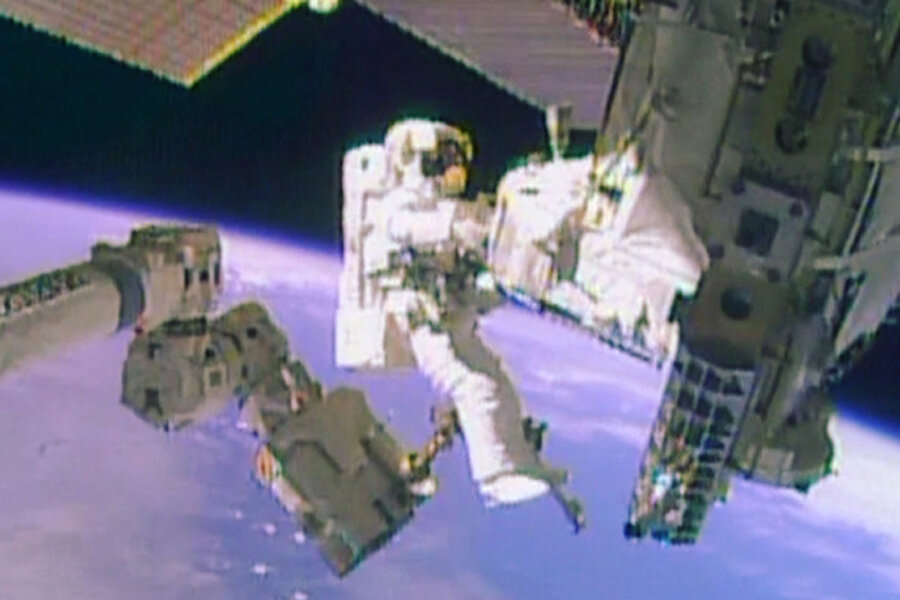After 7-1/2-hour installation, space station cooling pump passes tests
Loading...
Astronauts aboard the International Space Station successfully installed a new external cooling pump Tuesday during the second of two emergency spacewalks aimed at bringing the station's cooling system back to full capacity.
The apparent success leaves the entire crew free to enjoy a quiet Christmas Day, NASA says.
The new pump underwent a brief battery of tests Tuesday afternoon and all of its components were working properly. Mission controllers plan to perform more-extensive tests Tuesday evening. By Friday or Saturday, they expect to have the station and its cooling systems running at full capacity.
"Thank you guys," said Doug Wheelock, a NASA astronaut and Army colonel who took part in pump-replacement spacewalks in 2010 and who guided the spacewalking astronauts through Tuesday's operation. "It's the best Christmas ever."
On Dec. 11, a pump circulating ammonia coolant through one of two external cooling loops partially failed, preventing the loop from drawing away heat from inside the space station. Mission controllers had to reduce the load on the cooling system by shutting down non-essential systems in three of the $100 billion station's laboratory modules.
The malfunction also forced a delay in an Orbital Sciences Corporation resupply mission, which was to have launched Dec. 19. The new launch is slated to occur no earlier than Jan. 7, 2014.
The pumps are members of what the ISS program calls the Big 12 – a dozen major station components that require "contingency" spacewalks to repair them as quickly as possible.
US crew members Rick Mastracchio and Air Force Col. Mike Hopkins conducted an initial spacewalk Dec. 21 that lasted nearly 5-1/2 hours. They disconnected the coolant and electrical lines to the balky pump, moved it to a temporary storage location on the space station's truss, then placed the replacement pump on another temporary storage platform near the spot where it would be installed.
Initially, NASA had planned to conduct three spacewalks, with the third taking place on Christmas Day. Mr. Mastracchio and Col. Hopkins got more done than anticipated last Saturday. But the spacewalk was cut short after Mastracchio's suit was unable to keep his fingers and toes warm.
Still, the duo was able to get far enough ahead on their tasks to prompt NASA to cancel the third spacewalk.
Tuesday's outing lasted 7-1/2 hours and was the second Christmas Eve spacewalk in the history of human spaceflight. The first took place in 1999 during a Hubble Space Telescope servicing mission. It's also the 176th spacewalk that astronauts have conducted to build and maintain the orbiting outpost.
The outing began at 6:53 A.M. Eastern Standard Time. By 9:22, Japanese crew member Koichi Wakata was guiding the space station's robotic arm toward the spot where the new pump would go – with Hopkins on the arm's business end, manhandling the 780-pound replacement pump.
Although astronauts can enjoy expansive views of Earth during interludes in their spacewalks, their intense focus on their tasks can lead to some creative geography.
As Wakata held Hopkins and his refrigerator-size companion suspended near the installation site while Mastraachio finished his preparations there, Hopkins took time to take in the sights.
"How we doing, Mike?" Mastracchio asked.
"I'm doing fine," Hopkins replied.
"I guess you're a-waiting on me, huh?"
"Aah, it's a beautiful view," Hopkins said. "Yes, we're over the Pacific."
"We're always over the Pacific," Mastracchio quipped.
"Actually, you're directly in the center of the Atlantic," said Col. Wheelock, their guide at mission control.
After the two spacewalkers slid the replacement pump into its new home, they focused on connecting four coolant lines and five power cables – a process that look longer than expected because one of the coolant-line connectors repeatedly failed to unlatch properly as Hopkins tried to remove it from a temporary junction box.
After nearly an hour, the two finally disconnected the line.
Once all the connections were made, controllers pressurized each of the four lines to check for leaks. The process released a small flurry of ammonia ice, which surrounded the astronauts. Contact with the ammonia meant that the two spacewalkers had to undergo decontamination procedures just outside the airlock and inside as well to make sure they carried no ammonia to the station's interior.
Both spacesuits performed flawlessly, keeping fingers and toes warm and water out of the helmets. This was NASA's first set of spacewalks since water droplets infiltrated the helmet of a suit worn by astronaut Luca Parmitanok, a major in Italy's air force, during a spacewalk in July, nearly drowning him before he could return to the station and clear the air lock.
NASA is still investigating the incident. In the meantime, engineers devised simple snorkels for the suits that would allow astronauts to draw air from near their midsections. In addition, astronauts installed absorbent pads at the back of their helmets – where water first gathered in Maj. Parmitano's helmet.
Several times during Tuesday's spacewalk, Hopkins and Mastracchio were asked to stop for glove and pad checks to make sure the gloves had no tears and the pads were dry. Each time, the pads passed the "squishy test." If a pad feels squishy, the spacewalk is over.







